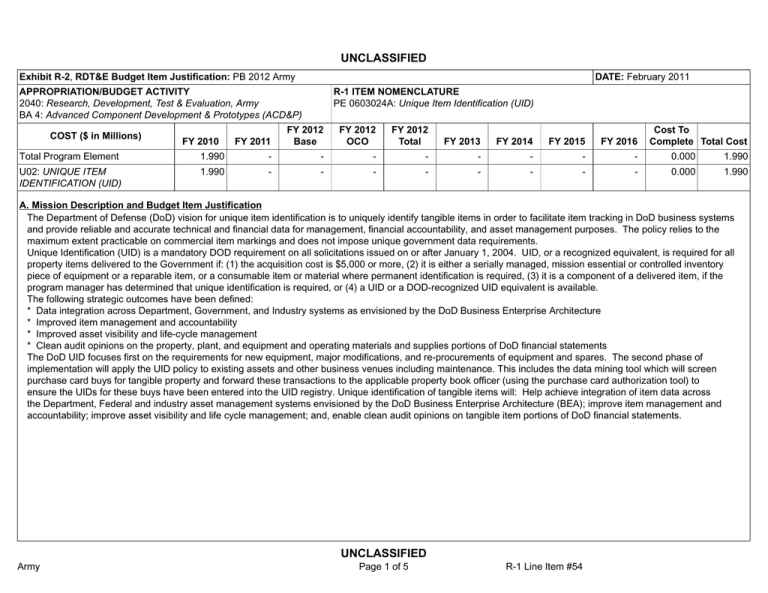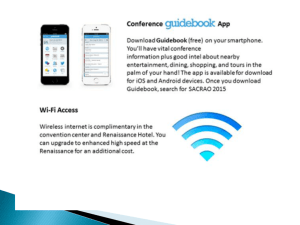UNCLASSIFIED
advertisement

UNCLASSIFIED Exhibit R-2, RDT&E Budget Item Justification: PB 2012 Army DATE: February 2011 APPROPRIATION/BUDGET ACTIVITY 2040: Research, Development, Test & Evaluation, Army BA 4: Advanced Component Development & Prototypes (ACD&P) COST ($ in Millions) FY 2010 FY 2011 R-1 ITEM NOMENCLATURE PE 0603024A: Unique Item Identification (UID) FY 2012 Base FY 2012 OCO FY 2012 Total FY 2013 FY 2014 FY 2015 FY 2016 Cost To Complete Total Cost Total Program Element 1.990 - - - - - - - - 0.000 1.990 U02: UNIQUE ITEM IDENTIFICATION (UID) 1.990 - - - - - - - - 0.000 1.990 A. Mission Description and Budget Item Justification The Department of Defense (DoD) vision for unique item identification is to uniquely identify tangible items in order to facilitate item tracking in DoD business systems and provide reliable and accurate technical and financial data for management, financial accountability, and asset management purposes. The policy relies to the maximum extent practicable on commercial item markings and does not impose unique government data requirements. Unique Identification (UID) is a mandatory DOD requirement on all solicitations issued on or after January 1, 2004. UID, or a recognized equivalent, is required for all property items delivered to the Government if: (1) the acquisition cost is $5,000 or more, (2) it is either a serially managed, mission essential or controlled inventory piece of equipment or a reparable item, or a consumable item or material where permanent identification is required, (3) it is a component of a delivered item, if the program manager has determined that unique identification is required, or (4) a UID or a DOD-recognized UID equivalent is available. The following strategic outcomes have been defined: * Data integration across Department, Government, and Industry systems as envisioned by the DoD Business Enterprise Architecture * Improved item management and accountability * Improved asset visibility and life-cycle management * Clean audit opinions on the property, plant, and equipment and operating materials and supplies portions of DoD financial statements The DoD UID focuses first on the requirements for new equipment, major modifications, and re-procurements of equipment and spares. The second phase of implementation will apply the UID policy to existing assets and other business venues including maintenance. This includes the data mining tool which will screen purchase card buys for tangible property and forward these transactions to the applicable property book officer (using the purchase card authorization tool) to ensure the UIDs for these buys have been entered into the UID registry. Unique identification of tangible items will: Help achieve integration of item data across the Department, Federal and industry asset management systems envisioned by the DoD Business Enterprise Architecture (BEA); improve item management and accountability; improve asset visibility and life cycle management; and, enable clean audit opinions on tangible item portions of DoD financial statements. Army UNCLASSIFIED Page 1 of 5 R-1 Line Item #54 UNCLASSIFIED Exhibit R-2, RDT&E Budget Item Justification: PB 2012 Army APPROPRIATION/BUDGET ACTIVITY 2040: Research, Development, Test & Evaluation, Army BA 4: Advanced Component Development & Prototypes (ACD&P) B. Program Change Summary ($ in Millions) Previous President's Budget Current President's Budget Total Adjustments • Congressional General Reductions • Congressional Directed Reductions • Congressional Rescissions • Congressional Adds • Congressional Directed Transfers • Reprogrammings • SBIR/STTR Transfer • Adjustments to Budget Years Army DATE: February 2011 R-1 ITEM NOMENCLATURE PE 0603024A: Unique Item Identification (UID) FY 2010 FY 2011 FY 2012 Base FY 2012 OCO FY 2012 Total - 1.990 1.990 - - - - - - - - - - - - - - - - - - - - - - - - - - 1.990 UNCLASSIFIED Page 2 of 5 R-1 Line Item #54 UNCLASSIFIED Exhibit R-2A, RDT&E Project Justification: PB 2012 Army DATE: February 2011 APPROPRIATION/BUDGET ACTIVITY 2040: Research, Development, Test & Evaluation, Army BA 4: Advanced Component Development & Prototypes (ACD&P) COST ($ in Millions) U02: UNIQUE ITEM IDENTIFICATION (UID) FY 2010 1.990 FY 2011 - R-1 ITEM NOMENCLATURE PROJECT PE 0603024A: Unique Item Identification (UID) U02: UNIQUE ITEM IDENTIFICATION (UID) FY 2012 Base - FY 2012 OCO FY 2012 Total - - FY 2013 - FY 2014 FY 2015 - FY 2016 - - Cost To Complete Total Cost 0.000 1.990 Quantity of RDT&E Articles A. Mission Description and Budget Item Justification The Department of Defense (DoD) vision for unique item identification is to uniquely identify tangible items in order to facilitate item tracking in DoD business systems and provide reliable and accurate technical and financial data for management, financial accountability, and asset management purposes. The policy relies to the maximum extent practicable on commercial item markings and does not impose unique government data requirements. Unique Identification (UID) is a mandatory DOD requirement on all solicitations issued on or after January 1, 2004. UID, or a recognized equivalent, is required for all property items delivered to the Government if: (1) the acquisition cost is $5,000 or more, (2) it is either a serially managed, mission essential or controlled inventory piece of equipment or a reparable item, or a consumable item or material where permanent identification is required, (3) it is a component of a delivered item, if the program manager has determined that unique identification is required, or (4) a UID or a DOD-recognized UID equivalent is available. The following strategic outcomes have been defined: * Data integration across Department, Government, and Industry systems as envisioned by the DoD Business Enterprise Architecture * Improved item management and accountability * Improved asset visibility and life-cycle management * Clean audit opinions on the property, plant, and equipment and operating materials and supplies portions of DoD financial statements The DoD UID focuses first on the requirements for new equipment, major modifications, and re-procurements of equipment and spares. The second phase of implementation will apply the UID policy to existing assets and other business venues including maintenance. This includes the data mining tool which will screen purchase card buys for tangible property and forward these transactions to the applicable property book officer (using the purchase card authorization tool) to ensure the UIDs for these buys have been entered into the UID registry. Unique identification of tangible items will: Help achieve integration of item data across the Department, Federal and industry asset management systems envisioned by the DoD Business Enterprise Architecture (BEA); improve item management and accountability; improve asset visibility and life cycle management; and, enable clean audit opinions on tangible item portions of DoD financial statements. B. Accomplishments/Planned Programs ($ in Millions, Article Quantities in Each) Title: unique identifier registry Articles: Description: The unique identifier registry has been deployed. As of 11 January 2006, 264 contractors are providing item unique identifiers allowing the department to individually track 78,964 newly procured items and 11,820 previously procured items. Combined there are 90,784 personal property entries into the registry. Full asset visibility for all functional areas will not occur until all systems from logistics, acquisition, transportation, property management, and financial are enhanced to support item unique identification. The following system enhancements bring the Defense Department closer to achieving full asset visibility. Army UNCLASSIFIED Page 3 of 5 R-1 Line Item #54 FY 2010 1.990 0 FY 2011 - FY 2012 - UNCLASSIFIED Exhibit R-2A, RDT&E Project Justification: PB 2012 Army DATE: February 2011 APPROPRIATION/BUDGET ACTIVITY 2040: Research, Development, Test & Evaluation, Army BA 4: Advanced Component Development & Prototypes (ACD&P) R-1 ITEM NOMENCLATURE PROJECT PE 0603024A: Unique Item Identification (UID) U02: UNIQUE ITEM IDENTIFICATION (UID) B. Accomplishments/Planned Programs ($ in Millions, Article Quantities in Each) FY 2010 FY 2011 FY 2012 The capability to track government furnished property shipments to contractors has been developed in the wide area workflow system. The unique identifier registry has been enhanced to collect and maintain item unique upgrades or major overhauls effecting the life cycle and or cost of that specific item. The Defense Medical Logistics Support System has been enhanced to support item unique identification. The Plant Clearance and Lost Damaged Destroyed system used by the Defense Contract Management Agency to manage personal property has been redesigned to support item unique identification. The site unique identification registry has been established and is being populated to provide the Department of Defense visibility of real property across the department. FY 2007 and out years will continue with analysis design, development and integration of the unique identification registries. FY 2010 Accomplishments: The unique identifier registry has been deployed. As of 11 January 2006, 264 contractors are providing item unique identifiers allowing the department to individually track 78,964 newly procured items and 11,820 previously procured items. Combined there are 90,784 personal property entries into the registry. Full asset visibility for all functional areas will not occur until all systems from logistics, acquisition, transportation, property management, and financial are enhanced to support item unique identification. The following system enhancements bring the Defense Department closer to achieving full asset visibility. The capability to track government furnished property shipments to contractors has been developed in the wide area workflow system. The unique identifier registry has been enhanced to collect and maintain item unique upgrades or major overhauls effecting the life cycle and or cost of that specific item. The Defense Medical Logistics Support System has been enhanced to support item unique identification. The Plant Clearance and Lost Damaged Destroyed system used by the Defense Contract Management Agency to manage personal property has been redesigned to support item unique identification. The site unique identification registry has been established and is being populated to provide the Department of Defense visibility of real property across the department. FY 2007 and out years will continue with analysis design, development and integration of the unique identification registries. Accomplishments/Planned Programs Subtotals C. Other Program Funding Summary ($ in Millions) Line Item • 432612: OMA APE FY 2010 14.047 FY 2011 14.402 FY 2012 Base FY 2012 OCO FY 2012 Total FY 2013 FY 2014 FY 2015 1.990 - Cost To FY 2016 Complete Total Cost 0.000 28.449 D. Acquisition Strategy The Unique Identification UID) acquisition strategy will make extensive use of Integrated Product Teams (IPTs) consisting of in-house matrix and contract support. The strategy will be accomplished via performance-based acquisition procurement efforts. Spiral software development will be employed through the evolutionary acquisition of time-phased requirements through blocks of capability building on preceding blocks while ongoing to full, interoperable capability. UID must support Army UNCLASSIFIED Page 4 of 5 R-1 Line Item #54 - UNCLASSIFIED Exhibit R-2A, RDT&E Project Justification: PB 2012 Army DATE: February 2011 APPROPRIATION/BUDGET ACTIVITY R-1 ITEM NOMENCLATURE PROJECT 2040: Research, Development, Test & Evaluation, Army PE 0603024A: Unique Item Identification (UID) U02: UNIQUE ITEM IDENTIFICATION (UID) BA 4: Advanced Component Development & Prototypes (ACD&P) the near term needs of the acquisition community while achieving the long-term goal of a collaborative business enterprise environment. The evolutionary acquisition approach UID is taking will acquire contractor support and services for program management and integration early in its acquisition life cycle phases. Phased implementation and incremental development will align with the Acquisition Business Enterprise Architecture. Implementation of maturing technology and commercial off-the-shelf software (COTS) will provide the necessary flexibility for building an Information Technology environment to sustain a collaborative business enterprise and achieve the Department of Defense goal for a Global Information Grid (GIG). E. Performance Metrics Performance metrics used in the preparation of this justification material may be found in the FY 2010 Army Performance Budget Justification Book, dated May 2010. Army UNCLASSIFIED Page 5 of 5 R-1 Line Item #54


